Trees
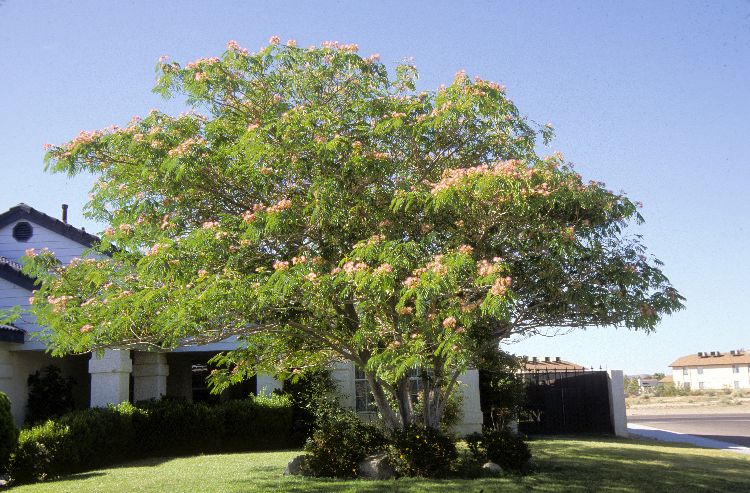
Albizia julibrissin
Silk Tree
Multiple trunk forms are common for Silk Tree. Flowers are dramatic, almost subtropical in nature. Flower litter can be messy. Canopy coverage: 1,257 square feet.
[Read More]Arbutus 'Marina'
Marina Strawberry Tree
This hybrid Arbutus does best with some sun protection in hot desert and inland areas. Becomes an attractive tree with age, with interesting form and brown bark that peels to reveal new, smooth, red bark beneath. Edible, ball-shaped fruit follow the pink flowers in late winter. Fruit can be messy on pavement. Canopy coverage: 962 square feet.
[Read More]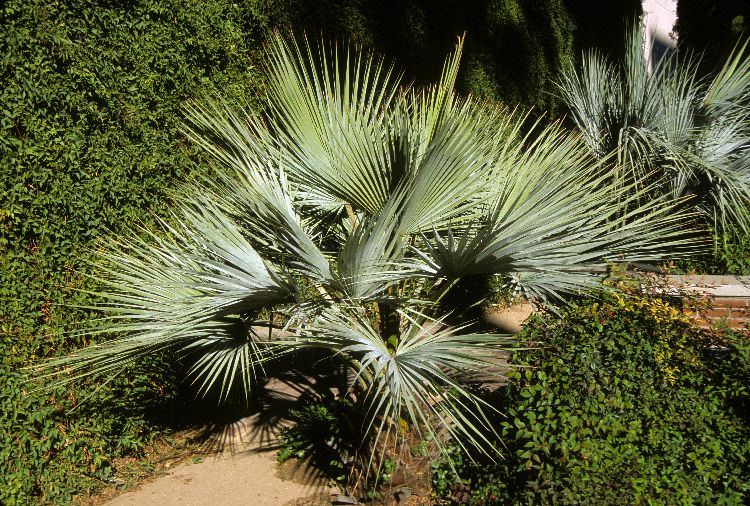
Brahea armata
Mexican Blue Palm
Mexican Blue Palm is a tropical, fan-type palm that is very slow growing. Canopy coverage: 79 square feet.
[Read More]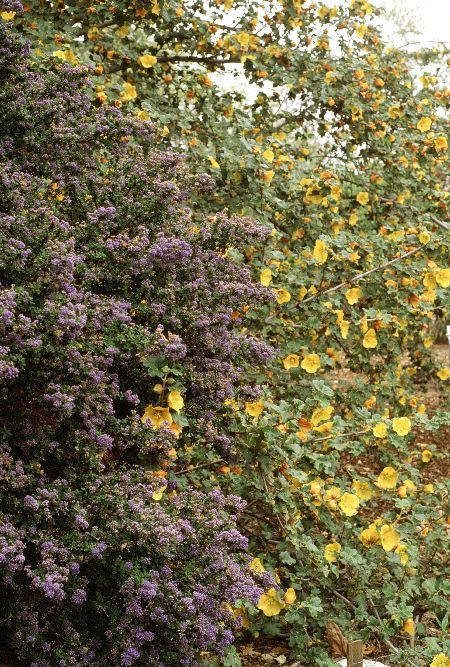
Ceanothus 'Ray Hartman'
Ray Hartman Wild Lilac
The most popular of the large Ceanothus, due to its handsome appearance and acceptance of a range of soil types, drought, as well as both coastal and inland climates. Fast-growing, it can be trained to become a small tree in a matter of years. Avoid watering in summer, however, except to establish new plants the first year. Canopy coverage: 314 square feet.
[Read More]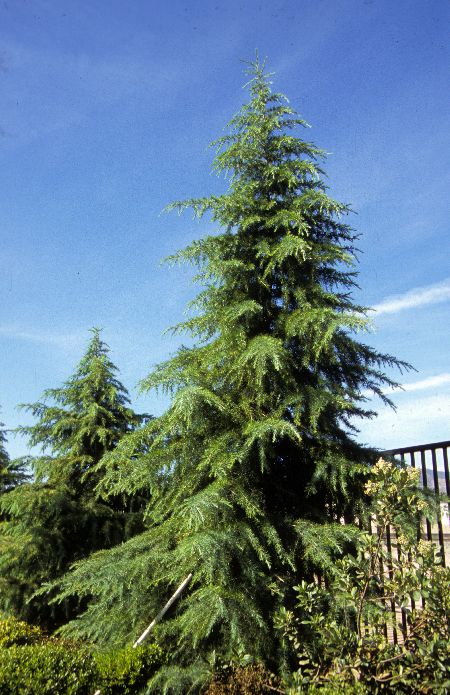
Cedrus deodara
Deodar Cedar
Be certain to allow plenty of space for Deodar Cedar. It is a long-lived tree that can reach huge proportions. It has a distinctive, cascading form due to its moderately weeping growth habit. Accepting of hot, dry conditions. Canopy coverage: 1,257.
[Read More]Cercis canadensis
Eastern Redbud
Eastern Redbud is an attractive small tree for home landscapes. Flowers appear early in spring on bare branches, even before the leaves emerge. Yellow fall color. Selections with different flower colors are also available. Accepts sandy to loam soils; prefers moist soil but not soggy. Requires protection from winter temperatures in coldest regions. Canopy coverage: 707 square feet.
[Read More]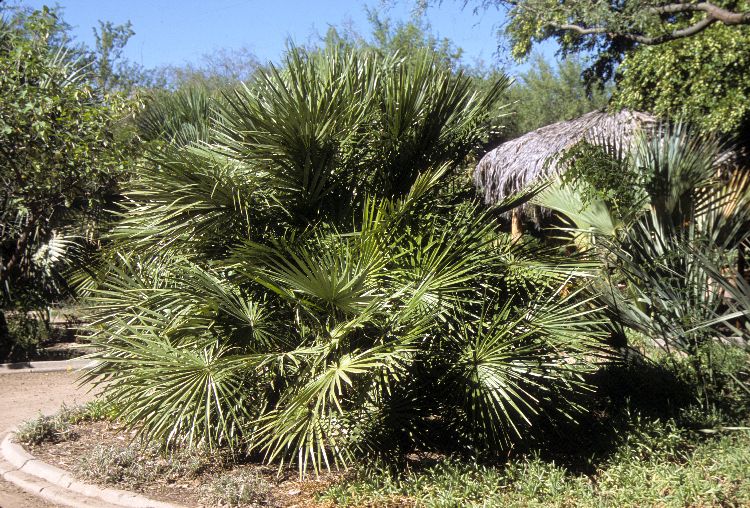
Chamaerops humilis
Mediterranean Fan Palm
This is a small, fan-type palm with a mature size (to 10 feet) to remain in scale for residential use. Best with some protection from the sun in hot summer regions. Canopy coverage: 50 square feet.
[Read More]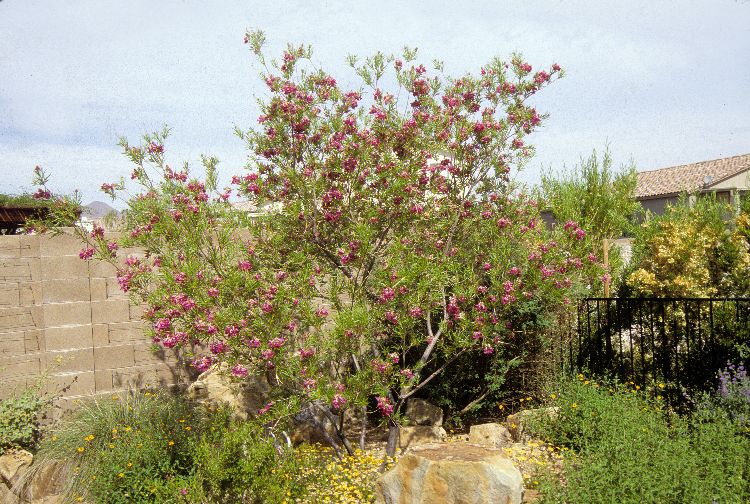
Chilopsis linearis
Desert Willow
Desert Willow is a bulletproof tree for hot-summer regions. Weeping form is appealing, as are the spring flowers. Long brown to tan seedpods add interest in winter. Many selections are available in a range of colors. Canopy coverage: 314 square feet.
[Read More]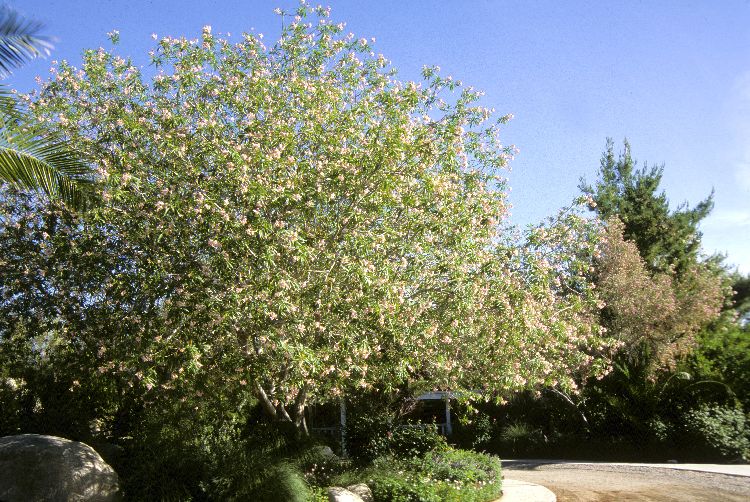
Chitalpa x tashkentensis
Chitalpa
Chitalpa is a hybrid of two genera: Chilopsis and Catalpa. It is a tough plant, accepting summer heat. Striking flowers and lush evergreen form are attractions. Many flower colors available. Look for the improved selection 'Morning Cloud'. Canopy coverage: 707 square feet.
[Read More]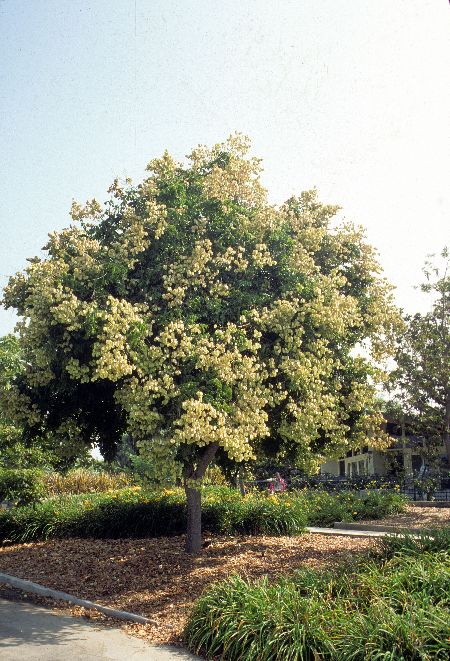
Koelreuteria paniculata
Goldenrain Tree
The open, branching form of Goldenrain Tree produces light shade. Papery fruit capsules emerge red then turn brown. Best with some protection from the sun in hot summer regions. Canopy coverage: 962 square feet.
[Read More]Lagerstroemia indica
Crape Myrtle
Crape Myrtle can be successfully grown as a tree or shrub. It offers interest all year—flowers summer into to fall, fall color, and interesting sculptural branches during winter after leaves fall. Canopy coverage: 314 square feet.
[Read More]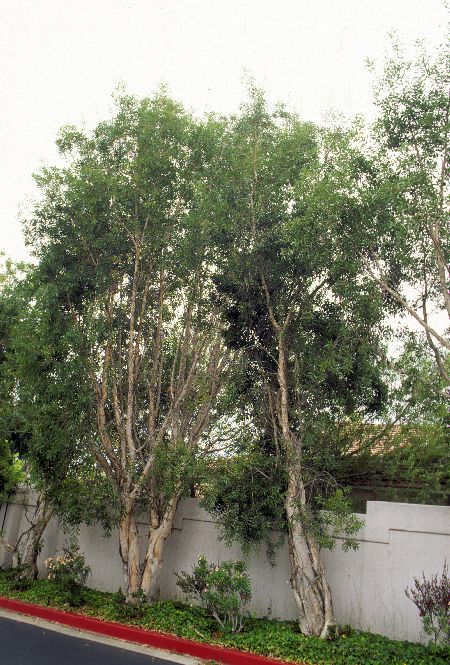
Melaleuca quinquenervia
Cajeput Tree
One of primary attractions of this Australian native is its deeply fissured, spongy bark along the trunk and major branches. Makes a slender, strongly vertical evergreen tree. Requires more moisture in hot inland and desert regions. Canopy coverage: 177 square feet.
[Read More]Parkinsonia 'Desert Museum'
Hybrid Palo Verde
This Palo Verde is a thornless horticultural selection with an attractive vase shape. A popular choice. Avoid overwatering especially in summer; don't plant in lawns. Can suffer from limb breakage in high winds. Canopy coverage: 491 square feet.
[Read More]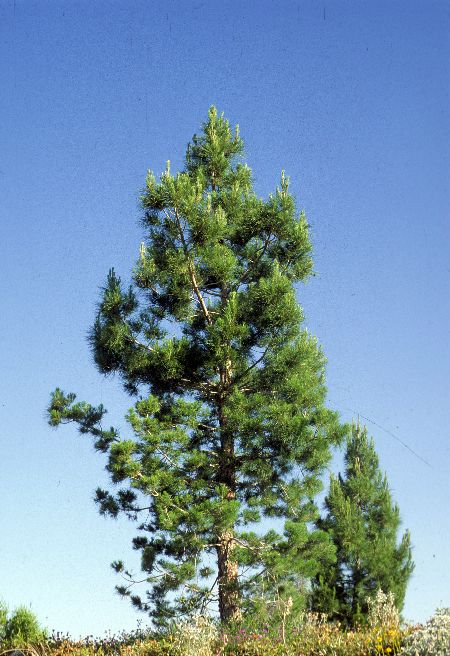
Pinus eldarica
Afghan Pine, Mondell Pine
Afghan pine is a tree with a symmetrical, pyramidal form. Brown cones 4 to 6 inches long add interest in summer. Effective and commonly used as a fast-growing windbreak. Canopy coverage: 491 square feet.
[Read More]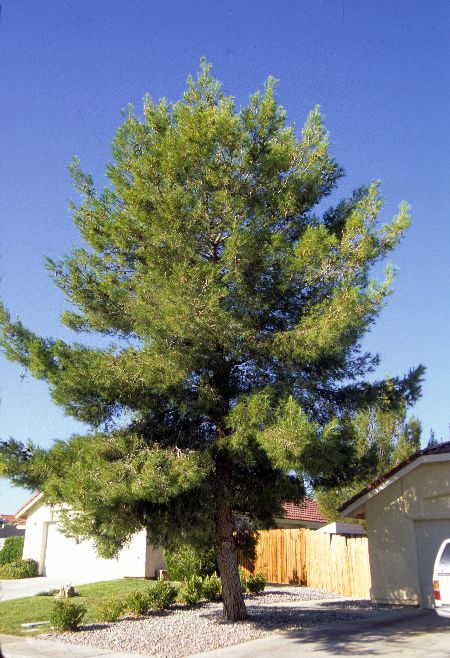
Pinus halepensis
Aleppo Pine
You can often Identify a mature Aleppo Pine due to its rounded, irregular form. Makes a nice large specimen tree. Canopy coverage: 491 square feet.
[Read More]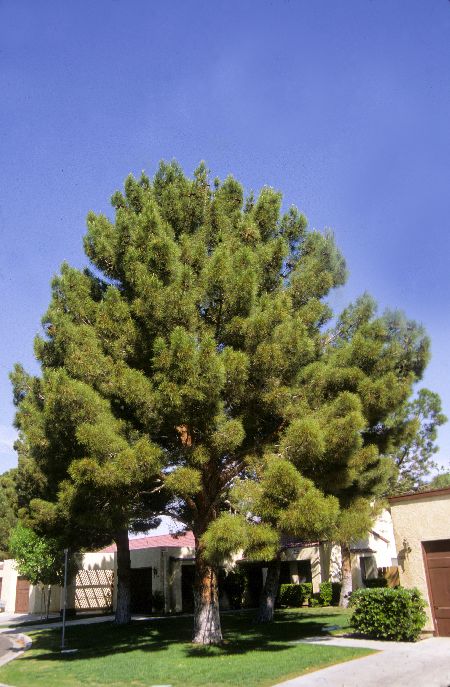
Pinus pinea
Italian Stone Pine
Stone Pine develops a flat-topped crown with age. Brown cones are ornamental in late summer. Edible nuts attract wildlife. Canopy coverage: 1,257 square feet.
[Read More]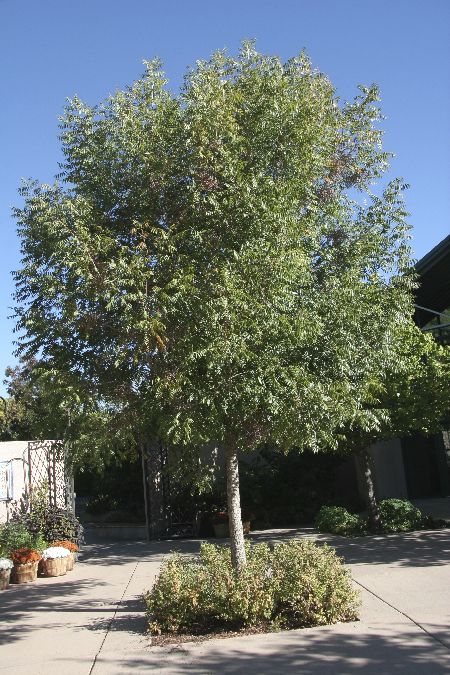
Pistacia chinensis
Chinese Pistache
Chinese Pistache is a great choice as a shade tree with the bonus of striking fall color in shades of gold and red. Canopy coverage: 962 square feet.
[Read More]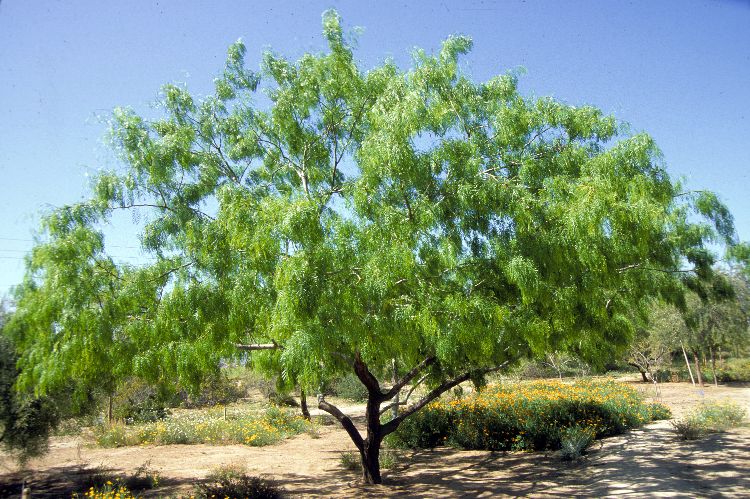
Prosopis glandulosa
Texas Honey Mesquite
This is a sprawling tree with character that takes time to develop. Its serious thorns require caution when pruning or grooming trees. 'Maverick' is a thornless selection. A similar tree is the Western Honey Mesquite. Its foliage is dark green compared to the bright green of Texas Honey. Canopy coverage: 707 square feet.
[Read More]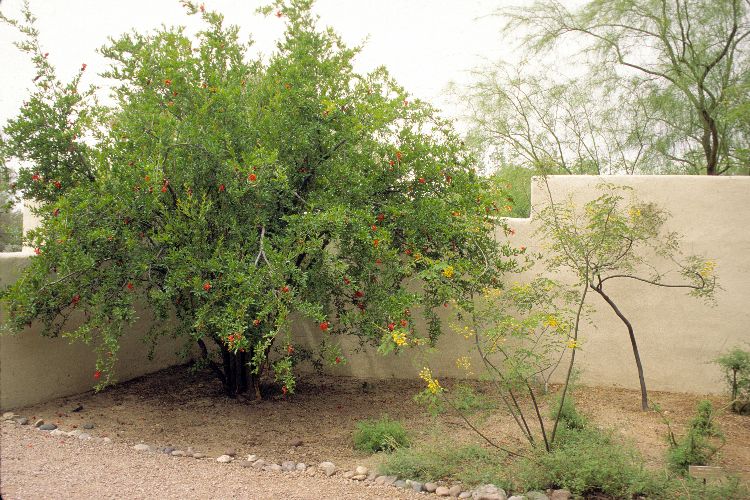
Punica granatum
Pomegranate
Pomegranate can be grown as a shrub or small tree. Edible fruit is a primary attraction. If fruit is the goal provide more water during summer. Canopy coverage: 113 square feet.
[Read More]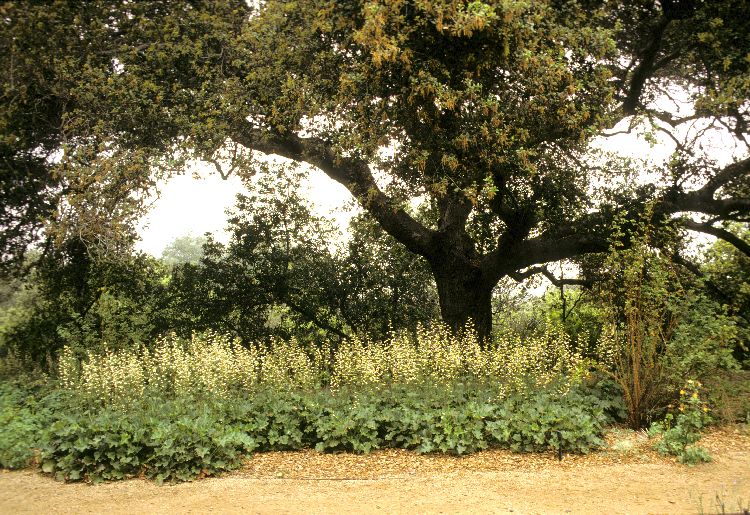
Quercus agrifolia
California Coastal Live Oak
California Coastal Live Oak is an outstanding shade tree of character where adapted. Spread is often greater than its height. Because it is native to an area with little summer rain, apply summer irrigations with caution. Leaves look much like those of holly: glossy dark green and crinkly. Canopy coverage: 1,963 square feet.
[Read More]Quercus engelmannii
Engelmann Oak, Mesa Oak
The natural habitat of this native California Oak is in the path of progress. Development in southern California has taken place (and continues) in the very regions where it likes to grow. Form is an open, spreading crown. Canopy coverage: 1,963 square feet.
[Read More]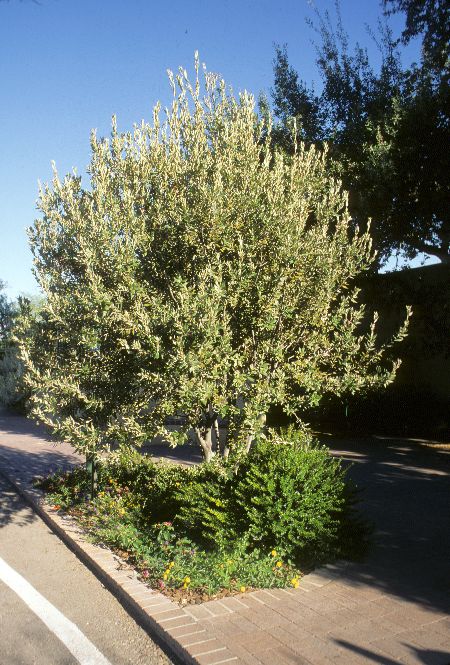
Quercus ilex
Holly Oak
Holly Oak can be grown as a tree or shrub, and actually makes a nice screen or hedge when planted close together. Canopy coverage: 1,963 square feet.
[Read More]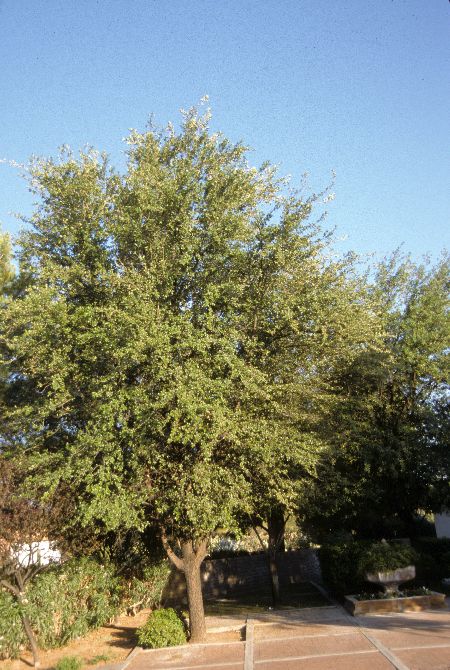
Quercus virginiana 'Heritage'
Southern Live Oak
This is a quality evergreen shade tree. Look for 'Heritage', which has shown to be well adapted to desert conditions. Canopy coverage: 2,827 square feet.
[Read More]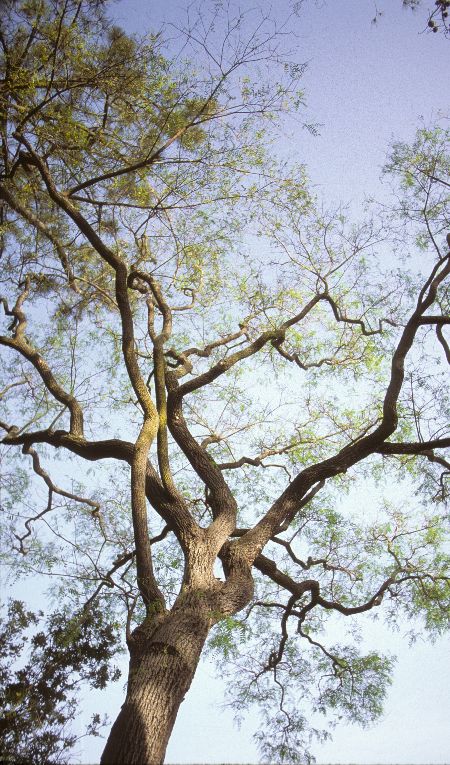
Tipuana tipu
Tipu Tree
The mature size range provided here is typical but be aware trees can grow much larger. Defining feature is the profuse amounts of flowers that bloom late spring into summer. Provides fast shade but give it plenty of room. Prune frequently and carefully to control and direct growth. Canopy coverage: 1,257 square feet.
[Read More]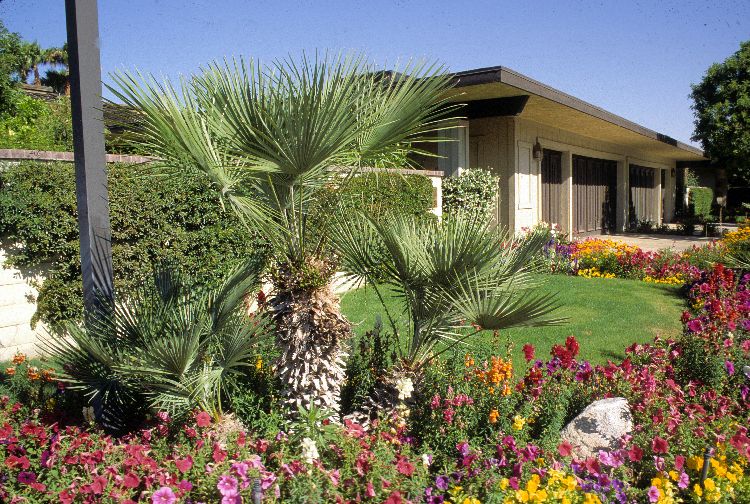
Trachycarpus fortunei
Windmill Palm
A primary value of this palm is that it remains in scale for home landscapes. Dark brown fibers on trunk as trees age add interest. Canopy coverage: 50 square feet.
[Read More]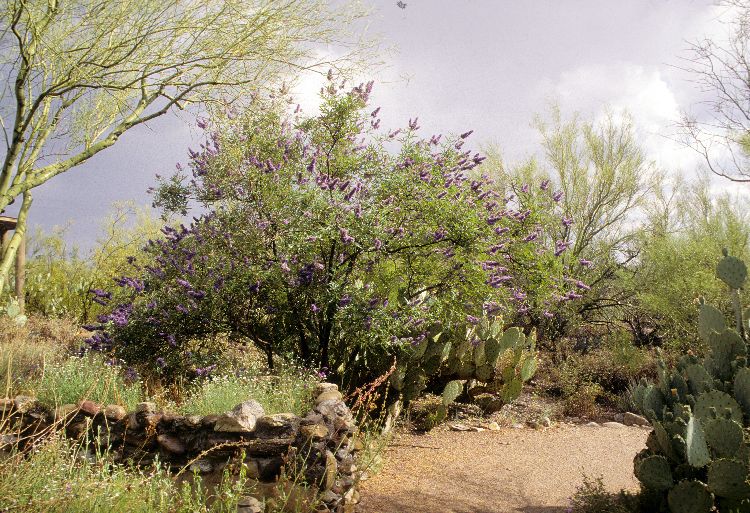
Vitex agnus-castus
Chaste Tree
Chaste Tree can be grown as a shrub or small tree. Makes a broad screen, although leaves drop in winter. Selections are available with pink or white flowers. Canopy coverage: 491 square feet.
[Read More]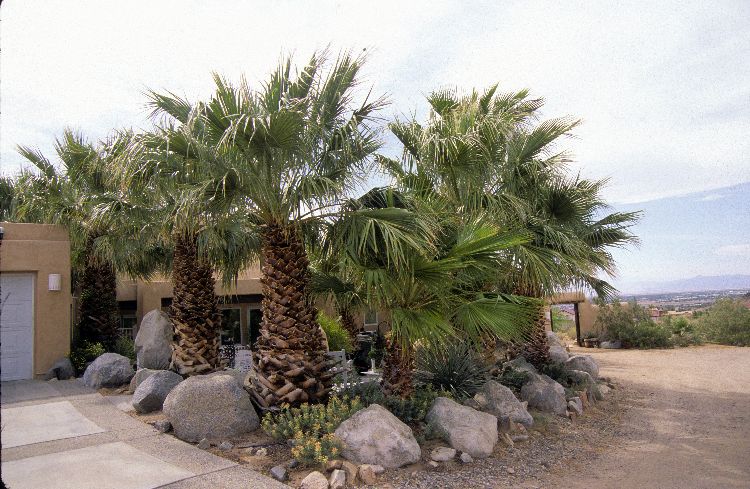
Washingtonia filifera
California Fan Palm
Very similar in appearance to Mexican Fan Palm, but California Fan Palm has a noticeably thicker and heavier trunk. Many gardeners leave the dead palm fronds on older palms, adding interest. Plant or transplant during warm season. Canopy coverage: 177 square feet.
[Read More]Shrubs
Arctostaphylos 'Sunset'
Sunset Manzanita
This is an easy-to-grow, dense, mounding shrub. New growth of Sunset Manzanita is coppery red, turning bright green. Attractions include the shredding bark, with contrasting light brown (mature) and rich brown (new) shades. Canopy coverage: 28 square feet.
[Read More]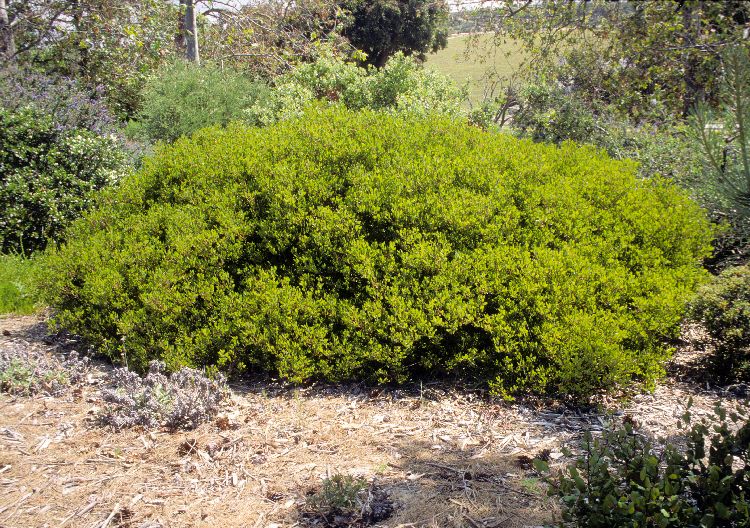
Arctostaphylos densiflora 'Howard McMinn'
Howard McMinn Manzanita
Provide this shrub with soil that has good drainage. Accepts low summer water but slow, deep infrequent irrigations are recommended. Striking bark color is mahogany with a purplish hue. Canopy coverage: 50 square feet.
[Read More]Baccharis pilularis 'Pigeon Point'
Dwarf Coyote Brush
This selection is a male plant, so it does not produce messy seed fluff. Leaves are larger and lighter green than other Baccharis selections. Cutting established plants back in late winter before new spring growth helps keep plants fresh looking. Reduce summer irrigations as plants become established. Gets by on a couple of irrigations during the warm season but better with once-a-month irrigations in hot summer regions. Canopy coverage: 50 square feet.
[Read More]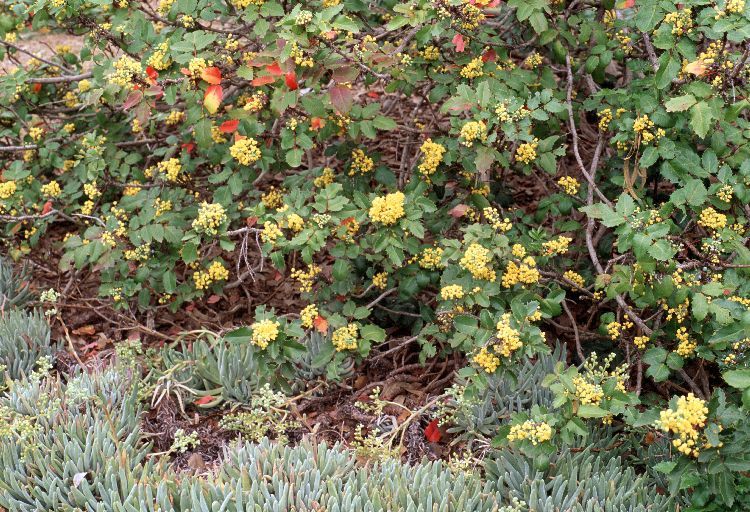
Berberis 'Golden Abundance'
Oregon Grape
Mature size and dense, erect branches of 'Golden Abundance' makes it ideal for a screen or hedge. Well adapted to hot inland regions. It has lots of attributes: bright yellow spring flowers; edible blue berries that attract birds in summer and fall; colorful fall color. Canopy coverage: 28 square feet.
[Read More]Berberis nevinii
Nevin's Barberry
This California native is prized as a background or screen, attracting wildlife, particularly birds, due to the cover and shelter it offers, not to mention red berries in summer. Leaves are composed of leaflets that have sharp spines. It's an adaptable shrub that accepts drought. Canopy coverage: 79 square feet.
[Read More]Caesalpinia pulcherrima
Red Bird of Paradise
Provides a tropical effect in the landscape with its dramatic and exotic flowers. The species produces orange flowers; yellow-flowering forms are also available. Plant form is rounded and open. Canopy coverage: 28 square feet.
[Read More]Callistemon viminalis 'Little John'
Little John Bottlebrush
This hybrid native to Australia is a compact version of the species. Growing in a compact form, it produces the same bottlebrush-shaped flowers over a long period. Makes a mounding groundcover when planted in a mass. Canopy coverage: 7 square feet.
[Read More]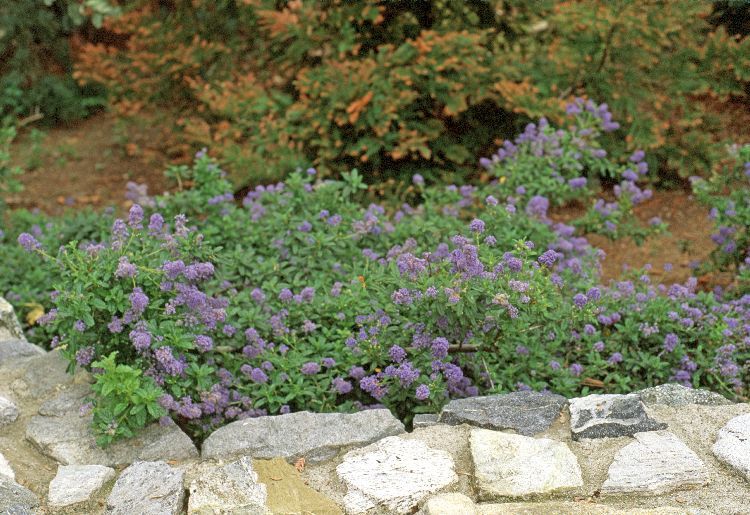
Ceanothus 'Joyce Coulter'
Joyce Coulter Ceanothus
Excellent choice for a wide-spreading, mounding groundcover. Listed as spreading to 12 feet but can spread even further. May require some pruning to maintain low, groundcover profile. Best in partial shade in hot inland areas. Known to be accepting of summer irrigation, but avoid too much water during this time. Canopy coverage: 113 square feet.
[Read More]Cistus x purpureus
Orchid Rock Rose
Leaves of Orchid Rock Rose are dark green above, grayish beneath. The large flowers have a distinctive red spot on each petal. Its casual growth habit is a good choice for naturalistic landscapes. Canopy coverage: 13 square feet.
[Read More]Cistus x skanbergii
Pink Rock Rose
Pink Rock Rose is a dense, compact, sun-loving shrub that produces profuse amounts of small, light pink flowers during spring and into summer. Soft gray-green leaves provide an ideal backdrop. Cut back late in summer for more flowers during fall. Canopy coverage: 20 square feet.
[Read More]Cotoneaster dammeri
Bearberry Cotoneaster
Bearberry Cotoneaster is a reliable groundcover, remaining low to the ground while spreading wide. Best with some protection from the sun in hot summer regions. Orange-red berries adorn plants in late summer. Reddish bronze fall color. Popular selections are 'Coral Beauty' and 'Lowfast'. Canopy coverage: 79 square feet.
[Read More]Crassula ovata
Jade Plant
Jade Plant is a popular and easy to grow succulent that can reach medium-sized shrub proportions. Also grown as a easy-care houseplant in regions with freezing temperatures. A fine candidate for container culture outdoors, then move to shelter before winter cold comes on. Easy to propagate from leaf cuttings. Supply with well-draining soil and do not overwater. Canopy coverage: 13 square feet.
[Read More]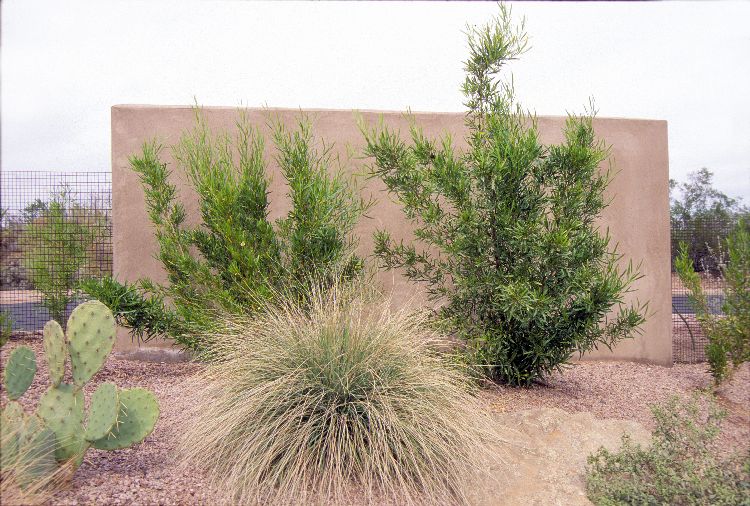
Dodonaea viscosa
Hop Bush
Hopbush makes an excellent dense screen in a short time. It can also be trained to become a small tree. Plants can be shortlived. Also consider Purple Hopseed Bush, which has striking bronze-colored leaves. Canopy coverage: 79 square feet.
[Read More]Epilobium canum garrettii
Hummingbird Trumpet
Hummingbird Trumpet is a colorful, low-growing subshrub (small shrub) that can also serve as a groundcover. Ideal for a naturalistic garden. Strong blooming period comes on late in the season when color is not as common so it is more appreciated. It may be sold as Zauschneria. 'Orange Carpet' is an improved selection. Canopy coverage: 13 square feet.
[Read More]Ericameria laricifolia
Turpentine Bush
Mounding, low-growing form allows use as small shrub or groundcover. Small daisylike flowers borne in clusters are profuse late summer into winter. Foliage emits distinctive scent when brushed. Canopy coverage: 7 square feet.
[Read More]Frangula californica
Coffeeberry, California Buckhorn
This large shrub has a mounding and rounded growth habit. The common name Coffeeberry is due to its berries contain seeds that look like coffee beans. The berries are more of an attraction than its flowers, becoming red, then purple then black, and are loved by birds. Canopy coverage: 50 square feet.
[Read More]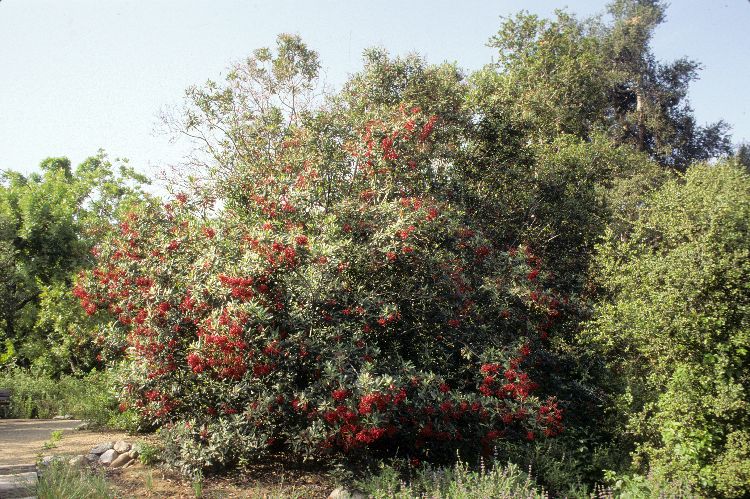
Heteromeles arbutifolia
Toyon
This is a handsome tall-growing shrub or small tree highly useful as a background or screen. Dark green leaves have serrated edges. Hollylike berries follow the summer flowers in fall, remaining on the plant into winter. Canopy coverage: 177 square feet.
[Read More]Juniperus chinensis 'Sea Green'
Sea Green Juniper
You will notice this shrub Juniper in the landscape due to its fountainlike form. In addition to being an attractive specimen plant, it makes an admirable hedge or medium-sized screen. Best with some protection from the sun in hot summer regions. Canopy coverage: 28 square feet.
[Read More]Juniperus sabina 'Buffalo'
Buffalo Juniper
Buffalo Juniper has appealing, bright green to olive green foliage. Leaves grow on long stems that spread horizontally close to the ground, forming a tight-knit mat. Accepts tough conditions. Attractive when it drapes and trails over ledges. Canopy coverage: 50 square feet.
[Read More]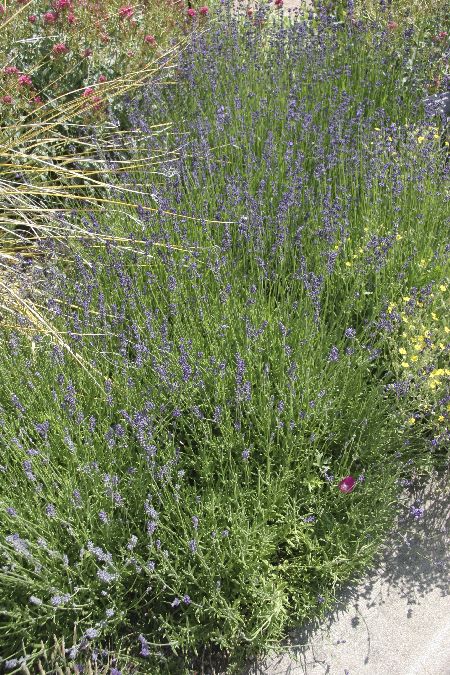
Lavandula angustifolia 'Munstead'
English Lavender
English Lavender is the most common Lavender and considered to be one of the easiest to grow. Flowers are highly fragrant. The species is shrublike and reaches 3 feet high and as wide. 'Munstead' is a dwarf form that grows to 1-1/2 feet high and as wide. Also look for 'Hidcote', with deep purple flowers. Canopy coverage: 3 square feet.
[Read More]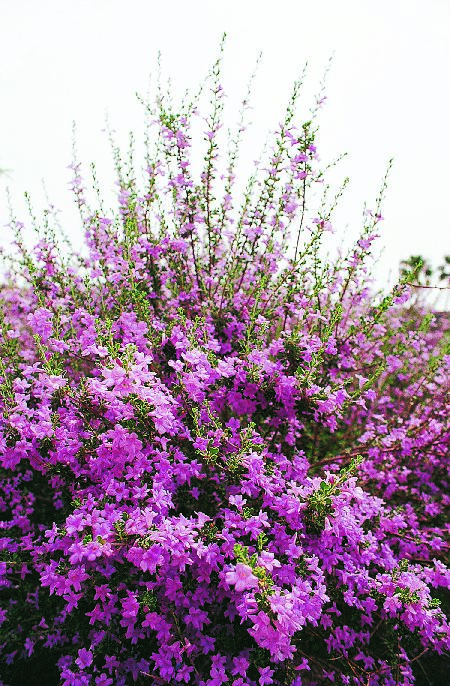
Leucophyllum langmaniae
Cinnamon Sage
Cinnamon Sage has a rounded form that is evergreen and similar to other Texas Rangers, but this species tends to be more dense. 'Rio Bravo' is an improved selection. Canopy coverage: 20 square feet.
[Read More]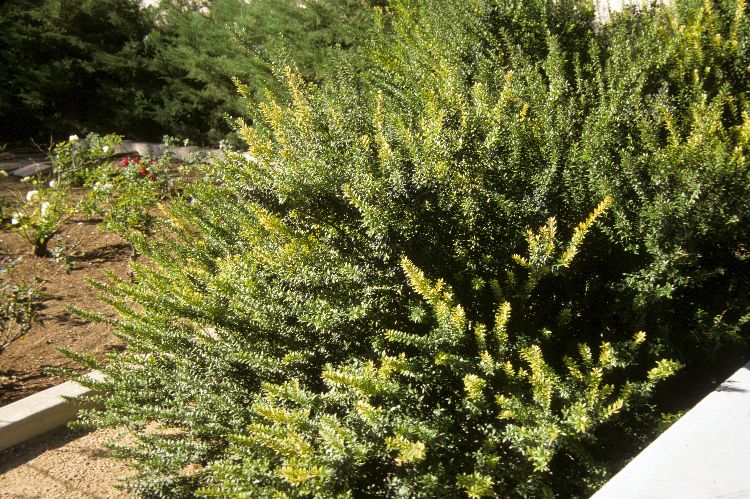
Myrtus communis
True Myrtle
Look for 'Compacta', Dwarf Myrtle, for a smaller scale planting. It grows to 4 feet high and as wide. 'Variegata' has bright yellow-green leaves. Canopy coverage: 79 square feet.
[Read More]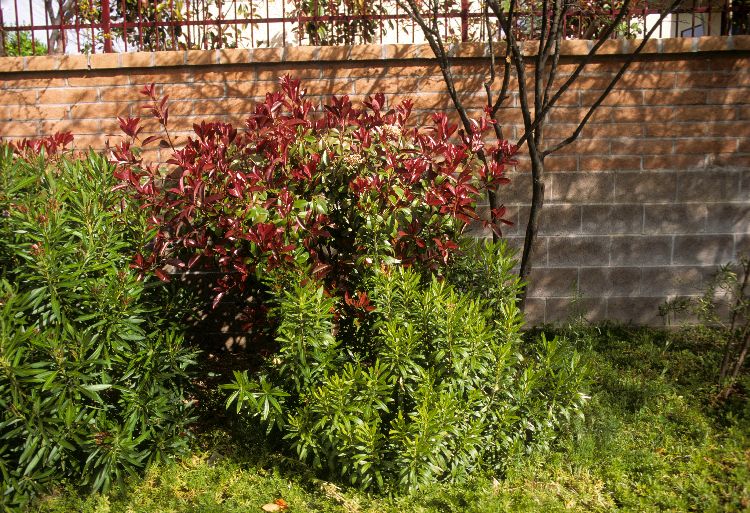
Photinia x fraseri
Redtip Photinia
Redtip Photinia makes an excellent screen or background planting. New growth in early spring is bright coppery red, which gradually turns medium green. Canopy coverage: 20 square feet.
[Read More]Plumbago auriculata
Cape Plumbago, Cape Leadwort
The slender, vining branches of Cape Plumbago create a mounding shrub or groundcover. It is cold hardy to about 15F although foliage is damaged at 25F. However, plant regrows quickly the following spring. Sometimes grown as a houseplant that vacations outdoors during summer. Attractive flowers are in bloom for a long period. Select a cultivar such as 'Royal Cape' or 'Imperial Blue' for deeper blue blooms. Canopy coverage: 79 square feet.
[Read More]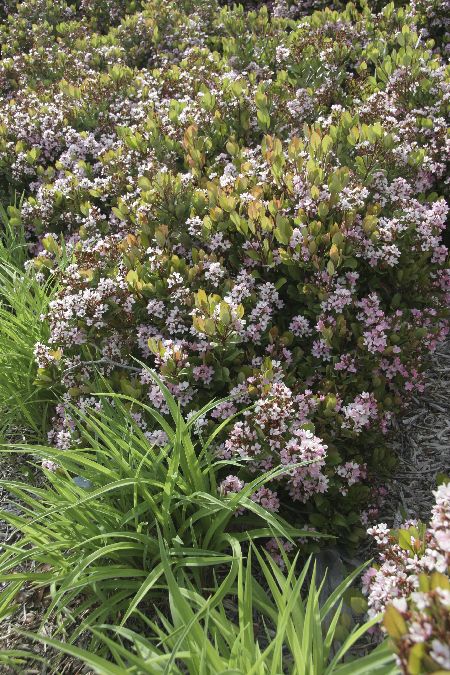
Rhaphiolepis indica
Indian Hawthorn
Glossy, leathery leaves are an attraction. Best with some protection from the sun in hot summer regions. Check your local nursery for improved selections that offer different flower colors such as 'Jack Evans', bright pink flowers; and 'Clara', white flowers. Canopy coverage: 28 square feet.
[Read More]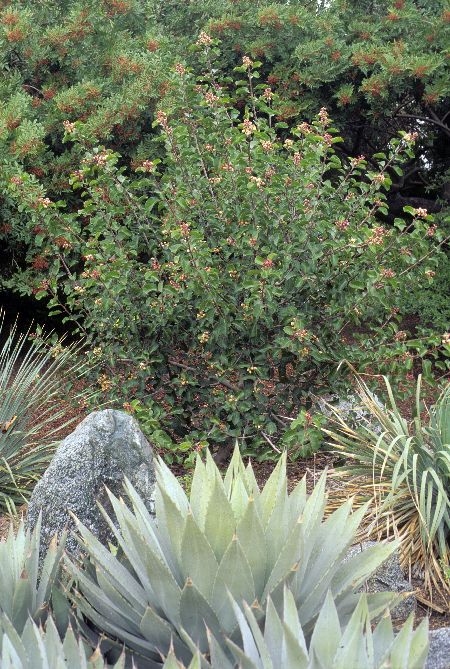
Rhus ovata
Sugar Bush
The dense, rounded form of Sugar Bush is excellent as a screen or hedge. Flowers emerge as red buds then become flowers that bloom in cream-colored clusters. Canopy coverage: 79 square feet.
[Read More]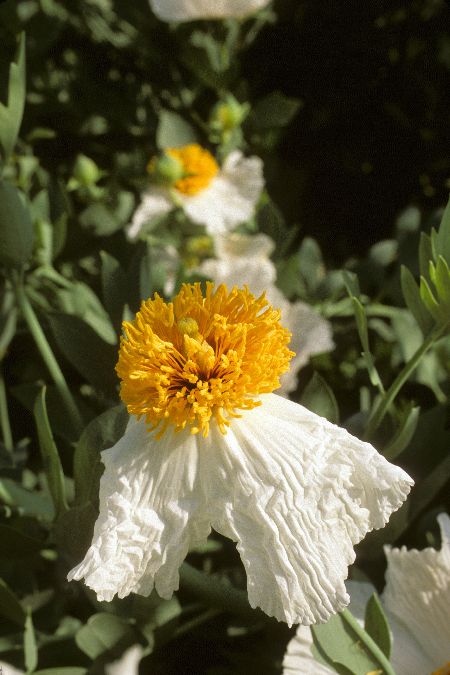
Romneya coulteri
Matilija Poppy
Grown for its spectacular, crepe paper flowers up to 9 inches across. They are pure white with a yellow center, thus one of its common names Fried Egg Plant. Best for an informal, naturalistic landscape. Canopy coverage: 28 square feet.
[Read More]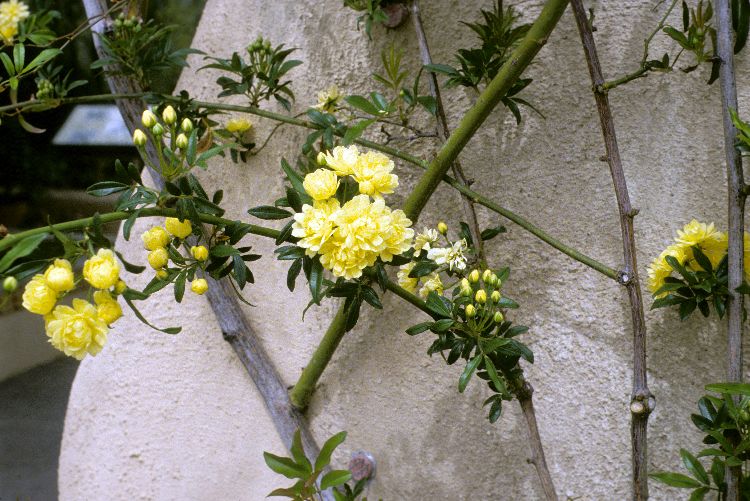
Rosa banksiae
Lady Banks' Rose
Lady Bank's Rose is a sprawling Rose that has no thorns and requires little maintenance. Plants can grow quite large with time. 'Lutea' features pale yellow flowers; 'Alba Plena' has white flowers. Canopy coverage: 491 square feet.
[Read More]Rosa californica
California Wild Rose
This California native develops into a thicket, becoming a thorny, barrier plant, excellent for wildlife habitat and as a security planting. It has other appealing features: profuse fragrant flowers, long bloom period, and orange-red hips, the seed capsules of Roses. To renew declining plantings, cut back canes severely in fall. Wear gloves and protective gear to defend yourself from the sharp, curved thorns. Canopy coverage: 79 square feet or more. Photos courtesy of Pam Pavela.
[Read More]Rosmarinus officinalis
Rosemary
Rosemary is a desirable shrub for its ability to accept tough conditions, featuring fragrant foliage valued for culinary use. Groundcover forms such as 'Prostrata' are wide-spreading. It is an excellent choice for draping and trailing over the edges of walls and containers. Canopy coverage: 13 square feet.
[Read More]Salvia clevelandii
Chaparral Sage
A California chaparral native that performs well in desert regions. Foliage has a pleasant, distinctive fragrance when brushed or following rain. Canopy coverage: 20 square feet.
[Read More]Salvia apiana
White Sagebrush
A sprawling form and color make this an easy to identify plant. Foliage is aromatic, particularly when brushed. Flowers are white and bloom in spikes above the 4-inch leaves, aging to light pink or lavender. It is a chaparral native so reduce watering in summer. Canopy coverage: 20 square feet.
[Read More]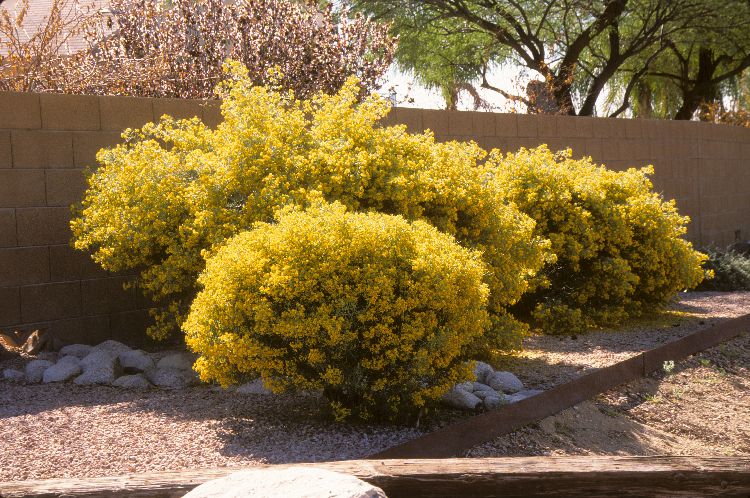
Senna artemisioides
Feathery Senna
Bright yellow flowers provide welcome color in early spring, although blooming periods can be variable. Foliage is distinctively feathery, and plant holds its refined form well following bloom. Canopy coverage: 28 square feet.
[Read More]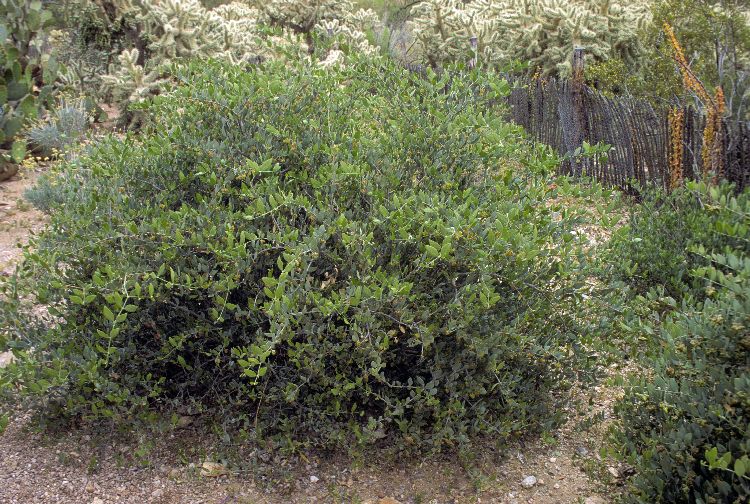
Simmondsia chinensis
Jojoba
Jojoba is a native shrub that is well-suited to desert landscapes, accepting the toughest conditions. Female plants produce acorns that are highly valued for their oil. Canopy coverage: 50 square feet.
[Read More]Tecoma stans
Yellow Bells
Yellow Bells can be semievergreen in cooler climates. Large, yellow, trumpet-shaped flowers are followed by interesting bean pods. Canopy coverage: 50 square feet.
[Read More]Groundcovers
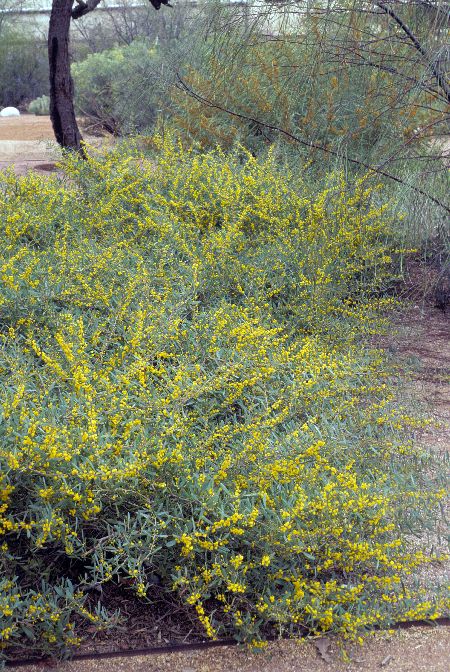
Acacia redolens 'Prostrata'
Trailing Acacia
Dense and wide-spreading, Trailing Acacia makes an excellent large area groundcover and to protect banks. A tough and forgiving plant. 'Desert Carpet' is an improved selection. Canopy coverage: 79 square feet.
[Read More]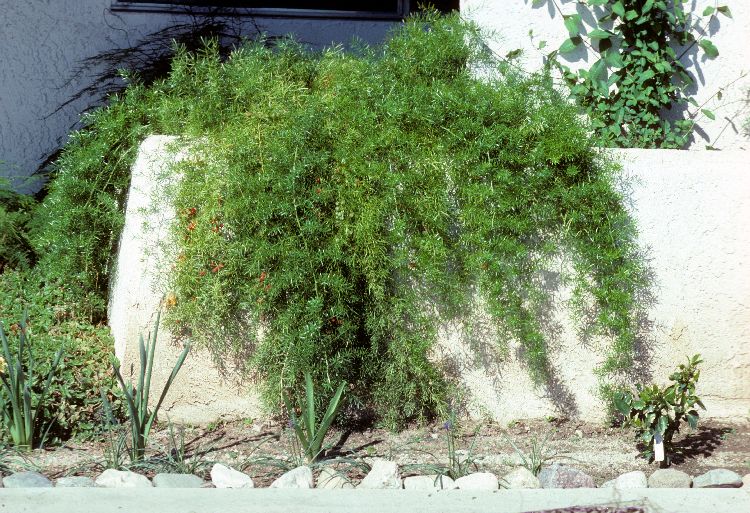
Asparagus densiflorus 'Sprengeri'
Asparagus Fern
Asparagus Fern is often used as a hanging, draping plant. Bright red berries are attractive against the bright green needlelike leaves. 'Myers' is a related selection with long, fluffy, foxtail stems. Canopy coverage: 7 square feet.
[Read More]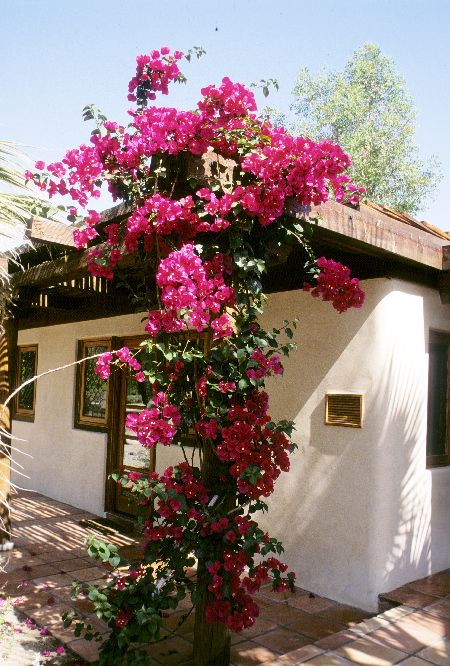
Bougainvillea varieties
Bougainvillea
Bougainvillea is a workhorse flowering vine or even groundcover, and one of best choices for subtropical landscapes. Many improved selections available in a range of colors. Plants produce a fair amount of litter so locate away from pools. Shrub forms are also available. Locate in a warm microclimate to help avoid frost damage. Canopy coverage: 707 square feet.
[Read More]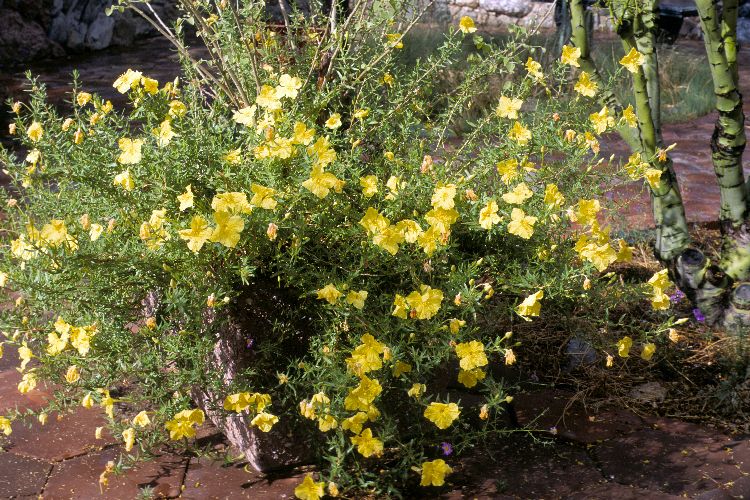
Calylophus hartwegii var. fendleri
Calylophus, Sundrops
Calylophus produces masses of large yellow flowers, blooming for a long period in spring. Excellent in rock gardens. Canopy coverage: 3 square feet.
[Read More]Lampranthus spectabilis
Trailing Ice Plant
From a practical viewpoint, this is a rapidly spreading plant that works well as a groundcover. But it's the brilliant flowers that catch the eye, blooming for a long period late winter into spring. Plants may be short-lived so be prepared to replant after three or four years. Accepts seaside conditions. Canopy coverage: 3 sqaure feet. Photos courtesy of Pam Pavela.
[Read More]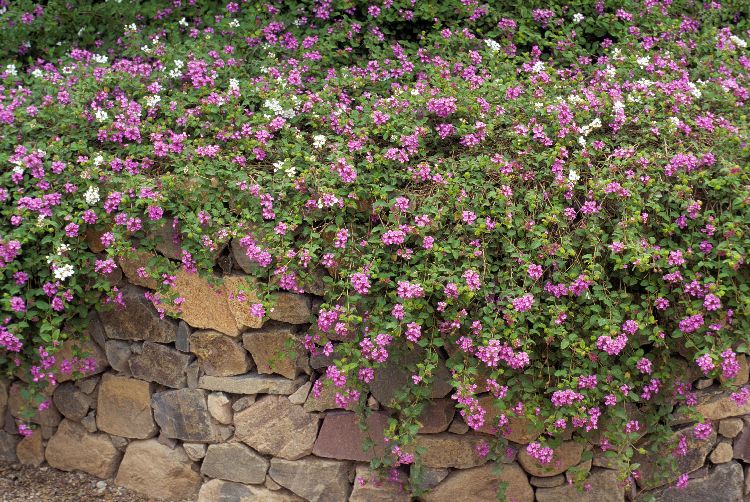
Lantana montevidensis
Trailing Lantana
Lantana has a long blooming season—spring into fall where winters are mild. Excellent groundcover or allow to drape over a ledge or large container. Canopy coverage: 7 square feet.
[Read More]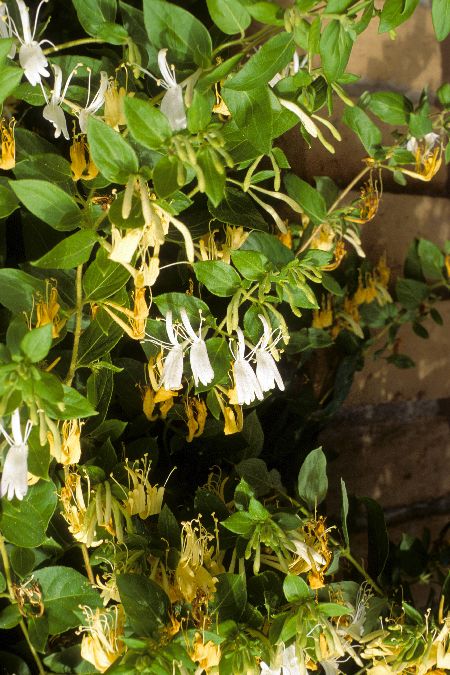
Lonicera japonica 'Halliana'
Hall's Honeysuckle
Hall's Honeysuckle can be grown as vine or groundcover. It is an aggressive grower that can become invasive, so be ready to control it. Fragrant flowers emerge as white then mature to yellow-gold. Canopy coverage: 491 square feet.
[Read More]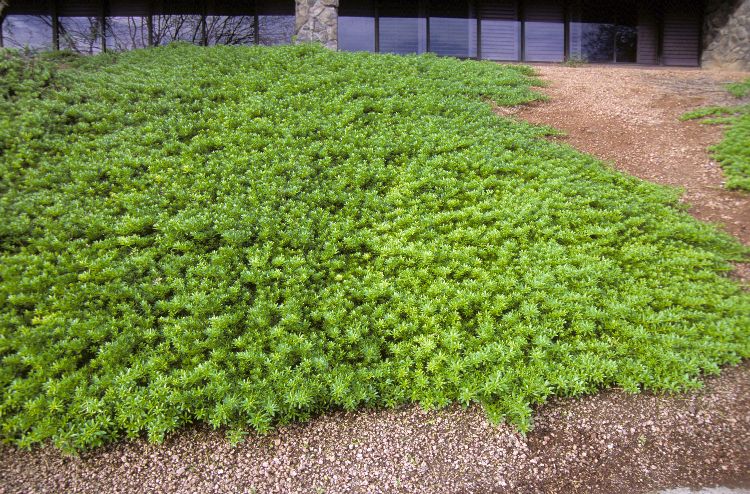
Myoporum parvifolium
Prostrate Myoporum
The foliage of Myoporum is rough in texture but the plant makes up for it as an excellent slope cover. Maintains low growth. Avoid overwatering or plant can die back in patches. Canopy coverage: 64 square feet.
[Read More]Vines
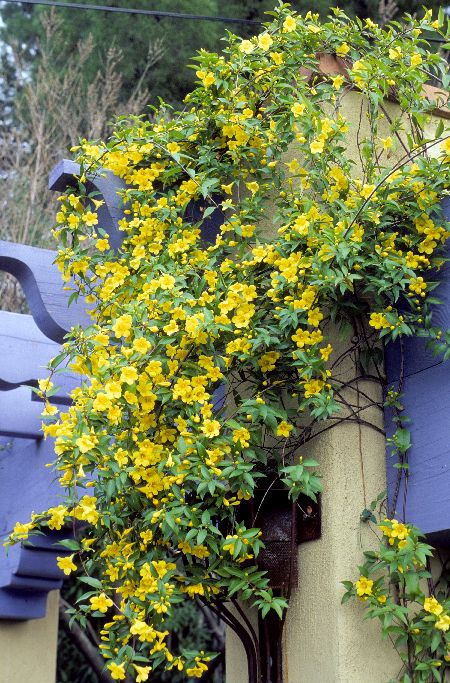
Gelsemium sempervirens
Carolina Jessamine
Carolina Jasmine has a twining growth habit. Use as vine or groundcover. Highly fragrant flowers bloom early in the season. Best with some protection from the sun in hot summer regions. Water requirement is reduced after plant matures. Be aware that all plant parts are poisonous. Canopy coverage: 314 square feet.
[Read More]Pandorea jasminoides
Bower Vine
For the most flowers, grow this vine in full sun but it will accept some shade. It can grow up to 30 feet high if given a sturdy support. Selections with a range of flower colors are available; check at your nursery. Canopy coverage: 314 square feet.
[Read More]Parthenocissus tricuspidata
Boston Ivy
This is an aggressive-growing vine that does equal service as a groundcover or bank cover. It blankets supports with a dense layer of wide leaves. Extravagant fall color comes in shades of orange to red. Canopy coverage: 1,963 square feet.
[Read More]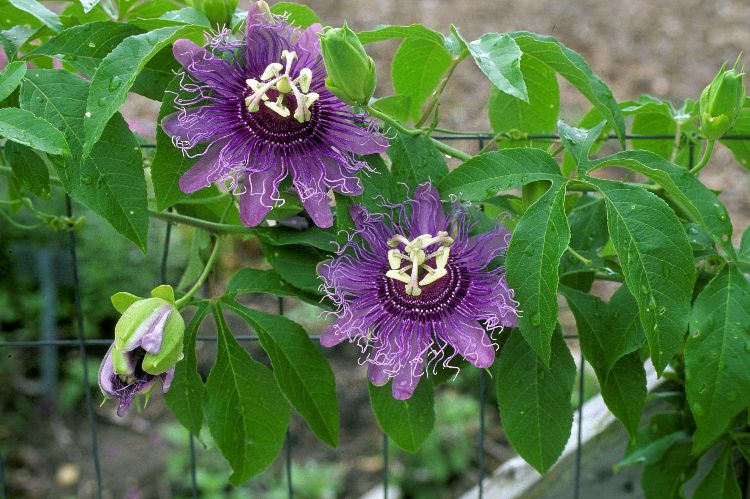
Passiflora belotii
Passion Flower Vine
The intricate, dramatic flowers of Passion Flower Vine grow up to 4 inches across, and are quite eye-catching. They bloom in masses during summer. Bright green, three-lobed leaflets support the subtropical effect. Best with some protection from the sun in hot summer regions. Canopy coverage: 707 square feet.
[Read More]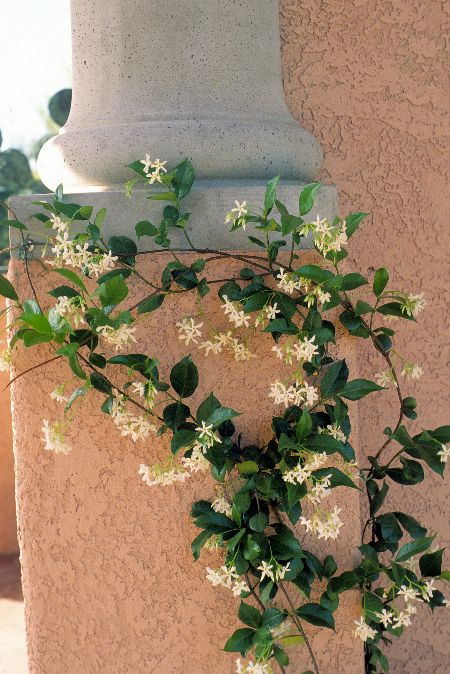
Trachelospermum jasminoides
Star Jasmine
Fragrance of the small, star-shaped flowers is like a sweet perfume, so much so you'll smell the flowers before you see them. Provide supports for the vines to climb. Best with afternoon shade. Canopy coverage: 707 square feet.
[Read More]Vitis californica
California Wild Grape
Produces tiny tart fruit but best grown for the luxurious shade it produces, ideally on an overhead structure. Leaves emerge gray and brighten to green, then turn red in fall before dropping. Vines regrow the following spring. ‘Rogers Red’ holds its gray-green leaf color all summer, then turns brilliant red and orange in fall. Canopy coverage: 707 square feet.
[Read More]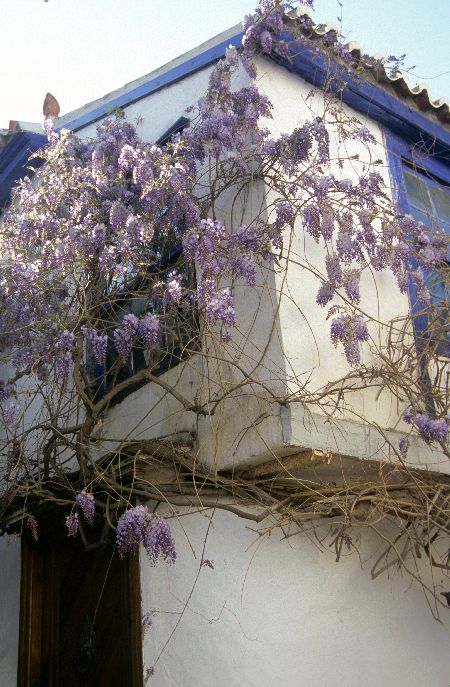
Wisteria sinensis
Chinese Wisteria
The flowers of Chinese Wisteria are profuse and bloom even before foliage emerges in spring, creating a spectacular show. 'Alba' has white flowers. Canopy coverage: 314 square feet.
[Read More]Ornamental Grasses
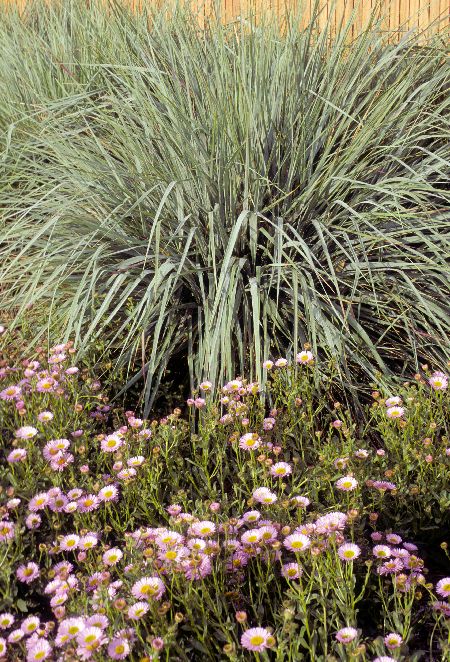
Elymus condensatus 'Canyon Prince'
Canyon Prince Wild Rye
This is an ornamental grass that prefers some afternoon shade. The foliage rather than flowers is its primary attraction. Canopy coverage: 1 square feet.
[Read More]Helictotrichon sempervirens
Blue Oat Grass
The growth habit of Blue Oat Grass is clumping and symmetrical. Attractive features include striking blue-green foliage (more blue than green) and seedheads on tall stems that rise well above the leaves. Foliage turns tan color in cold-winter regions. Canopy coverage: 3 square feet.
[Read More]Miscanthus sinensis
Japanese Silver Grass
Many selections of Japanese Silver Grass are available. 'Variegata' has attractive variegated leaves (shown). In hot summer regions locate plants where they will receive some afternoon shade. Canopy coverage: 13 square feet.
[Read More]Muhlenbergia capillaris
Pink Muhly
Seedheads are the attraction of Pink Muhly. 'Regal Mist' is an improved selection with fine-textured seedheads that present an airy "mist" of deep pink. Plants may be semievergreen. Canopy coverage: 13 square feet.
[Read More]Cacti
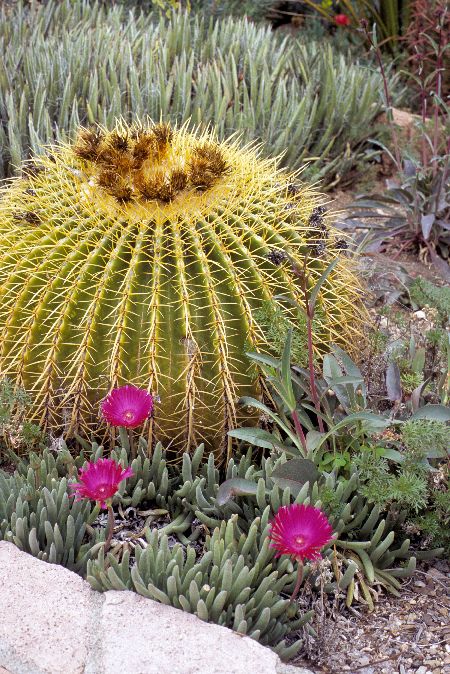
Echinocactus grusonii
Golden Barrel Cactus
Golden spines against medium green skin are the attraction of this cactus. Mass plantings make a striking statement, or it is effective as a single specimen in a container. Canopy coverage: 7 square feet.
[Read More]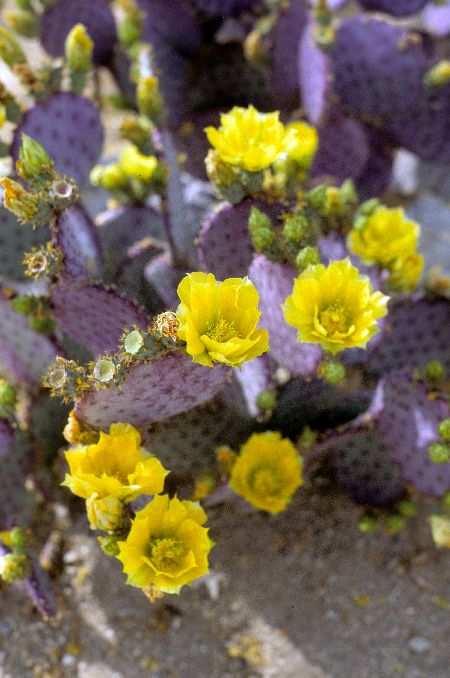
Opuntia santa-rita
Purple Prickly Pear
When conditions are dry or cold, the pads of Purple Prickly Pear often turn an attractive purplish color. Pads are usually armed with bristle-like spines. Canopy coverage: 20 square feet.
[Read More]Annuals
Pelargonium x hortorum
Garden Geranium
Geraniums are perennials typically grown as annuals in hot-summer or cold-winter regions. Plant from containers or packs in spring. These are old-fashioned plants that are grown as bedding plants, hanging baskets or even houseplants. Also look for scented geraniums, which are available in many rich fragrances.
[Read More]Succulents
Aeonium arboretum
Aeonium
An easy to grow succulent that is a prime choice along the coast. Provide with afternoon shade in warm inland regions. Not overly tolerant to cold, container culture is a good option to enable moving it to a sheltered location before winter frosts. Many selections are available. See 'Zwartkop', which is described in this database. Canopy coverage: 3 square feet.
[Read More]Agave 'Blue Glow'
Blue Glow Agave
An agave grown for its striking blue-green leaves. If possible, locate where you can view it when backlit by the sun. Prefers afternoon shade in hot-summer regions. Flowering is sporadic and make take years. Canopy coverage: 7 square feet.
[Read More]Agave parryi
Artichoke Agave, Parry's Agave
Artichoke Agave is one of the most decorative of all Agaves. It is worth the wait it requires to grow. As with most Agaves, plants typically die after blooming. Canopy coverage: 7 square feet.
[Read More]Fouquieria splendens
Ocotillo
Ocotillo is an iconic plant of the desert with a distinctive silhouette. A common name, Buggy Whip, helps describe its form. Canopy coverage: 177 square feet.
[Read More]Hesperaloe parviflora
Red Yucca
One of the best accent plants around. Common name is Red Yucca, but it is not a Yucca but a different genus, Hesperaloe. Yellow-flowering forms are available. The selection 'Brakelight' produces more intense red flowers. (See photos.) Canopy coverage: 20 square feet.
[Read More]Yucca filamentosa 'Golden Sword'
Adam's Needle
Adam's Needle is one of most cold hardy of all Yuccas. Selections with striped leaves such as 'Golden Sword', shown in photos, are also available. Canopy coverage: 13 square feet.
[Read More]Perennials
Gaillardia x grandiflora
Blanket Flower
This is a hybrid between Gallardia aristata and Gallardia pulchella. Mature size of plants range from 2 to 4 feet high, depending on the selection. In hot summer regions locate plants where they will receive afternoon shade. Many cultivated varieties are available. 'Arizona Sun' is a dwarf selection reaching less than 1 foot high. Canopy coverage: 3 square feet.
[Read More]Gaura lindheimeri
Gaura
Gaura grows in an open form with long, slender, arching branches. Plants die down in winter with cold temperatures, then regrow in spring. Canopy coverage: 13 square feet.
[Read More]Geranium sanguineum
Bloody Cranesbill
Bloody Cranesbill grows as a dense mound, with fragrant flowers borne on stems that rise above the leaves. Red fall color. Selections with different flower colors are available. Canopy coverage: 7 square feet.
[Read More]Hemerocallis hybrids
Daylily
Daylilies are available in a wide range of plant forms and types, from evergreen, semievergreen or deciduous. Flower colors and sizes are available in selections too numerous to mention. Check locally. Canopy coverage: 7 square feet.
[Read More]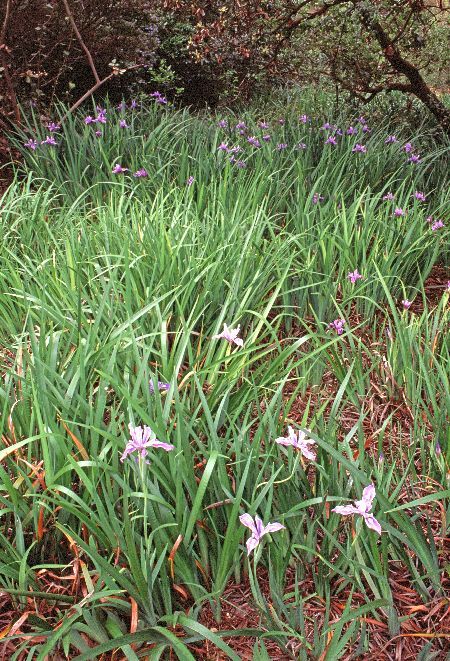
Iris douglasiana
Douglas Iris
Douglas Iris is one of the more forgiving Iris grown in the West. Vigorous growing, it accepts a range of exposures, from sun to shade. As typical of many California natives, accepts more sun near the coast, then less as one moves inland. Long (1 to 3 feet), narrow, sword-shaped leaves adorn plants. Not fussy as to water except avoid soggy soils. Canopy coverage: 3 square feet.
[Read More]Kniphofia uvaria
Red-Hot Poker
Red-hot Poker has an upright, clumping form. Dramatic flowers change color as they age: Blooms are first red then mature to yellow, making the tall flower stalks a two-toned affair. Hybrids are available in a range of colors. It doesn't like "wet feet" so provide with well-drained soil and don't overwater. Canopy coverage: 7 square feet.
[Read More]Lavandula dentata
French Lavender
You can identify this lavender by its square-toothed leaves. Flowers of French Lavender are typically short and lavender-purple in color. Flowers bloom for a long period in mild-winter regions. Canopy coverage: 7 square feet.
[Read More]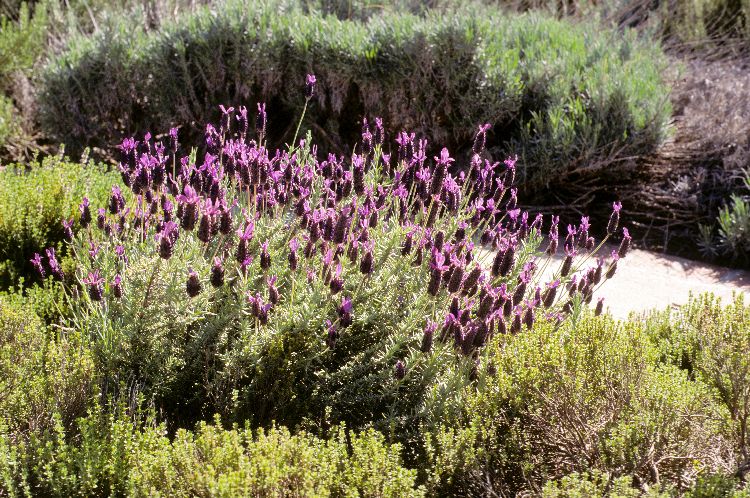
Lavandula stoechas
Spanish Lavender
Spanish Lavender is the most heat-tolerant lavender but prefers some afternoon shade in hot-summer regions. Both flowers and foliage emit the appealing lavender scent, especially when brushed or bruised. Canopy coverage: 7 square feet.
[Read More]Penstemon spectabilis
Royal Beardtongue
Like many Penstemons, Royal Beardtongue reseeds readily. The striking flowers bloom on tall spikes, attracting hummingbirds. Canopy coverage: 1 square foot.
[Read More]Thymus vulgaris
Garden Thyme, English Thyme
A Thyme useful for cooking and as an ornamental. Form may be somewhat variable. 'Argenteus', Silver Thyme, takes on more of a shrubby form. Leaves are green with a yellowish white band. Canopy coverage: 3 square feet.
[Read More]